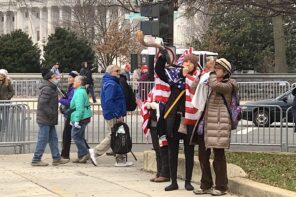The much publicized Israeli-Palestinian peace talks, heavily promoted by the Obama Administration, seem to have gone the way of earlier negotiations—that is, nowhere.
The Palestinian leadership has called for the suspension of all talks until the Israelis freeze settlement activity, a political move that Netanyahu’s coalition could not make and survive politically since the right wing of his coalition will brook no talk of territorial concessions in the West Bank. Israeli opposition leader Tzipi Livni has called on Netanyahu to save the peace talks, even at the price of losing his coalition partners: “Netanyahu must choose to act in the real long-term interest of Israel rather than in his own personal political interest.”
By Monday it became clear what Netanyahu is up against when an extreme faction within the West Bank settler movement attacked a mosque in the West Bank town of Beit Fajjar, setting it on fire and burning at least fifteen Qur’ans. The Israeli army, which has been contending with violent settler activity for decades is taking the incident very seriously. Military spokeswoman Colonel Avital Leibowitz told Reuters that, “this is a very serious incident which we view with utmost gravity and we intend to find those responsible as quickly as possible.”
Back on August 31, a few days before the opening of the current American-led Middle East peace talks in Washington, four Israelis were killed by Hamas operatives in the West Bank—among them a pregnant woman. Clearly, this didn’t bode well for the future of the talks, about which there was already a great deal of skepticism. But the Obama Administration, defying the odds, has soldiered on with the negotiations and done so despite the setbacks and the cynicism among the players themselves—the Israelis and the Palestinians as well as the neighboring Arab states.
Now, almost a month into the talks, the political and military situation continues to deteriorate. On September 12, three Palestinians were killed in Gaza by Israeli mortar fire—including, this time, a man in his nineties and his teenage grandson. Ten days later on September 22, a Palestinian man was shot dead by a security guard in East Jerusalem. A day of riots ensued.
What Have All This Superpower’s Efforts Reaped?
As this latest rond of talks appears to be sinking in the familiar quicksand of violence and politics it’s instructive to consider the recently published Jewish Terrorism in Israel, part of a new Columbia series on Terrorism and Irregular Warfare. Both authors are Israeli social scientists who teach at American universities. In this brief but rich book they give the English reader a much-needed survey of a subject that seldom gets much attention in the U.S. or Europe. (Within Israel, of course, the exploits of Jewish terrorists get considerable attention.)
Jewish Terrorism isn’t a wholesale condemnation of Israeli policies, but rather, a critique of some of its more radicalized political actors. While some critics, like Turkish Prime Minister Recep Tayyip Erdogan in the wake of the recent Turkish flotilla raid, have accused Israel of “state-sponsored terrorism,” Pedahzur and Perliger reserve their criticism for those Jewish activists who have embraced terrorism as a method and have through their actions deeply influenced the Israeli political processes. The most daring and successful of these actions was, of course, the 1995 assassination of Prime Minister Yitzhak Rabin, described by the authors as “an act carried out by a network of young religious Zionist Jews.”
The authors’ analysis of the radicalization of the Yigal Amir Group and their account of the assassination itself is a model of concise and dispassionate scholarship, providing a picture of the larger cultural and religious context of the Jewish settler movement from which Yigal Amir, a law student at Bar Ilan University, emerged.
Not long before the Rabin assassination one of the settler movement’s ideological leaders, Elyakim Haetzni, evoked the memory of World War II in his condemnation of the Rabin government’s “traitorous” policies, writing that “a government that is responsible for the death of Jews needs to know that its members may stand trial for treason, the same as in France when Nazi collaborators were sentenced to death.” And what was Rabin’s “treachery”? That he considered ceding parts of the West Bank to the Palestinians as part of a comprehensive peace treaty.
Noting that “terrorism is a problematic field to study… therefore most scholars tend to rely on secondary sources,” the authors were able to interview many of the people they write about. These included “twenty-five former terrorists, politicians, and spiritual leaders as well as law-enforcement officials.”
Before he coauthored this study of Jewish terrorism, Ami Pedahzur wrote about Arab terrorism directed at Israel. His 2006 book, The Israeli Secret Services and the Struggle against Terrorism, argued that Israel’s much-praised counter-terrorism policies were not successful, despite the headline-grabbing nature of some Israeli exploits. Like most Israelis of his generation (Pedahzur was born in 1970) he grew up admiring those exploits, the most famous and daring of which was the Entebbe rescue of 1976, during which Netanyahu’s older brother Jonathan was killed.
But, as he told an interviewer in 2009:
[A]fter a decade of studying terrorism and especially during the second Intifada with the long campaign of suicide attacks I started asking myself the following question: If Israel is indeed such a superpower in counterterrorism, as it wants the world to believe, why has terrorism against Israelis only intensified and become more deadly over the years?
His conclusion was that, despite the failure of its policies, the Israeli leadership, “due to political pressures, organizational interests, and emotional reflexes… tend to choose this failed approach over and over again.”
A Dour Prescription
Jewish terrorism begins even before the establishment of the State of Israel in 1948. The Irgun and the Stern Gang, groups formed under the influence of Vladimir Jabotinsky’s Revisionist Zionism, emerged in the 1930s and early 1940s. For the Irgun leaders (future prime minister Menachem Begin among them) the struggle to create a Jewish state in Palestine justified the use of violence. The Herut Party, formed by the Irgun leadership, was condemned as a “terrorist” organization by Hannah Arendt, Albert Einstein and others in a 1948 letter to the New York Times.
The Stern Gang, which broke with the Irgun in 1940, went beyond justifying violence to privileging and extolling it. Revisionist Zionists believed that the reason Jews were the targets of European violence was that they were “defeatist” and passive. Only military action and the creation of a sovereign Jewish state would save the Jews from their historical fate as Europe’s perpetual victims.
Jewish Terrorism concludes with a comprehensive “Chronology of Attacks and Events Related to Jewish Terrorism,” beginning with the September 1948 assassination of Count Bernadotte by members of the Stern Gang. Bernadotte was the U.N. mediator between the Arab states and the just-established State of Israel. His “crime” was trying to find a political solution for Jerusalem that would accommodate both Israeli and Arab needs.
In contrast to scholars and pundits who argue that Islam encourages political violence, Pedahzur and Perliger argue that all religions and ideologies may develop violent radical wings: “Religious terrorism is not a one-faith phenomenon. In fact, identical patterns of radicalization and the use of terrorism can be traced to any counterculture that adheres to a totalistic ideology, be it religious or secular.”
The book’s conclusions are very sobering, and in the light of the cynicism surrounding the current negotiations, very depressing:
It is true that radical Islamists to a certain extent justify their terrorism with their aspiration to help the Palestinian nation realize its nationalist goals and by claiming they are responding to the ongoing harm to Palestinians. However, even a movement such as Fatah, all the more so Hamas, Islamic Jihad, Hezbollah, and al-Qaeda, openly declare that they will not rest until the complete liberation of the Al-Aqsa Mosque is achieved [the Al-Aqsa Mosque is located on the same site in Old Jerusalem as the Temple Mount, the holiest site in Judaism].
On the other hand, although in much smaller numbers, there are Jews who regard the very presence of the mosques as an obstacle to the redemption of the people of Israel. A larger number hold a Kahanist worldview, according to which—irrespective of the conflict with the Palestinians—the Jewish state should cast out the Arab minority from within. Some of them are willing to try to implement this goal in a violent way or by means designed to bring about a violent escalation in the relations between Jews and Arabs.
After long years of studying Jewish terrorism in Israel, and in light of our journey to many of its focal points, we must conclude in a pessimistic tone. Despite the fact that in recent decades an almost absolute correspondence is evident between Jewish terrorism and the territorial conflict with the Palestinians, this is not a guarantee that this dependency will go on forever.
The potential for Jewish terrorism will remain even if the Israeli-Palestinian conflict finds some sort of resolution. It is possible to assume that, as in the past, Jewish terrorism will continue to be a real thorn in the side for the State of Israel; however, it won’t prove to be a strategic challenge. This conclusion should nevertheless be taken with a grain of salt. Harm—and it need not be severe—to the mosques on the Temple Mount by redemption seekers could open the doors to hell.




